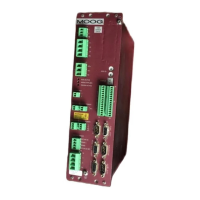
Do you have a question about the Moog T200 and is the answer not in the manual?
| Brand | Moog |
|---|---|
| Model | T200 |
| Category | Servo Drives |
| Language | English |
General safety information for using the manual and qualified personnel.
Regulations for safe operation, earthing, and protection.
Defines user roles and safety precautions for personnel.
General and specific safety requirements for equipment and installations.
Safety warnings for operating and servicing the equipment.
Requirements for selecting, wiring, and routing cables.
Guidelines for cable shielding and routing to minimize EMC noise.
Overview of EMC requirements and standards for the T200.
Overview of T200 models, ratings, and general specifications.
Details the eight base models of the T200 family and their coding system.
Specifications for T200 electronics regarding temperature, humidity, and protection.
Lists design standards the T200 adheres to, including CE and UL markings.
Information on power supply units (PSUs) and current ratings for the T200 family.
Details digital inputs, outputs, and other I/O specifications of the T200.
Lists required components for building a T200 servo-drive system.
Guidelines for panel or cabinet mounting of the T200.
Provides approximate equipment power dissipation values for cabinet cooling calculations.
Details the connectors on the T200-X10 and T200-X00 units.
General reminders on cable requirements, wiring practices, and earthing.
Describes the T200 servo-drive system and G4XX servo-motor compatibility.
Explains variations in G4XX motor models and electrical types.
Details methods for configuring the motor in the T200 servo-drive.
Guidance on selecting appropriate T200 and motor for applications.
Provides specifications for motor performance like temperature and protection.
Guidelines for mounting and installing motors, including dimensions and coupling.
Describes a quick start method for setting up a T200 motor-drive system.
Lists prerequisites for setting up the T200 drive and system.
Details the sequence for applying logic power to the T200 for initialization.
Guides the user through configuring the T200 using WinDrive.
Instructions for activating WinDrive and connecting to the T200.
Guides the user through selecting the motor type and downloading data.
Details how to select the reference source for the T200.
Guides setting operational limits for torque and velocity.
Instructions for setting up hardware limit switches and Quick-Stop deceleration.
Guides basic tuning of the drive in Velocity Mode.
Instructions for setting up the T200's encoder simulation.
Guides selection of the proper regen resistor for the user's configuration.
Instructions on saving parameter settings to non-volatile memory.
Steps for enabling the T200 and checking motor movement.
Recommended sequence for powering down the T200 safely.
Describes the T200's functionality, modes, and I/O, and introduction to WinDrive/HHT.
Provides an overview of T200 functional options.
Details the ±10V analog command interface for torque, velocity, or position.
Explains the T200's CAN fieldbus connection and modes.
Describes the T200's emulation of a stepper motor interface.
Explains how the T200 generates velocity commands based on digital inputs.
Describes the T200's standalone motion control capability.
Covers commonly understood conventions for T200 operation.
Details the power interface for different T200 models and high power sections.
Describes the function of analog and digital inputs/outputs.
Explains the internal function generator for square wave and spline shape signals.
Provides an overview of T200 control loops.
Outlines faults detected by the T200 and user indication methods.
Details self-protection mechanisms including torque limits and thermal protection.
Explains how the T200 generates encoder formatted output signals.
Describes the quadrature incremental encoder input on the T200.
Details the T200's stepper motor interface mode and hardware limit switches.
Describes communication interfaces like RS232, RS485, and CAN.
Explains non-volatile storage for user-programmable parameters.
Introduces WinDrive GUI and Hand Held Terminal as user interface options.
Details system requirements and installation procedures for WinDrive.
Guides on how to start WinDrive and establish communication with the drive.
Explains establishing communication link using RS232 or RS485.
Describes RS232 and RS485 serial standards for WinDrive communication.
Details the password protection feature for user access levels.
Describes the layout and features of the WinDrive main window.
Covers general features like floating toolbar, help system, and main window console.
Details the options available in the WinDrive menu bar.
Explains monitoring features like Data Logger and Engineering User Interface.
Details the configuration and tuning using the Hand Held Terminal.
Guides on establishing serial communications for the HHT.
Explains the format for commands used in the terminal interface.
Guides the servo-drive initialization process.
Details how to configure motor parameters.
Steps for configuring standard MOOG motors.
Steps for configuring non-standard or third-party motors.
Refers to Section 6 for a comprehensive overview of tuning control loops.
Lists commands for the hand-held terminal interface.
Defines CAN (Controller Area Network) as a high-speed serial interface.
Provides instructions for daisy-chaining CAN cabling between T200 units.
Explains how to use the troubleshooting section and lists common problems.
Addresses issues where power status LEDs fail to illuminate.
Troubleshooting for the Mains-Applied LED not lighting on T200-X10 units.
Troubleshooting for the DC-Bus-Active LED not lighting.
Troubleshooting for the Regen-Active LED always lighting on T200-X10 units.
Explains conditions indicated by the T200's 7-segment display.
Troubleshooting for a non-illuminated 7-segment display.
Troubleshooting for a constant 'P' display, indicating motor or software configuration issues.
Lists and describes fatal faults indicated by the 'F' symbol.
Lists and describes warnings indicated by the 'U' symbol.
Lists problems not necessarily identified by T200 diagnostics messages.
Provides contact information for technical support for WinDrive and Moog products.
Details test configurations for EMC-related CE-Compliance.
